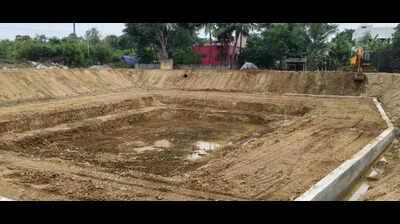Seven Thirukazhukundram ponds to get new life | Chennai News – Times of India

Chennai Seven neglected ponds at Thirukazhukundram are being revived under a 5.62 crore govt initiative.The Thirukazhukundram Special Grade Municipality launched a project last year to restore 16 ponds. “Of these 16, work on Sunambu Kulam, Vannam Kulam, Seran Kulam, and Navalur Kulam was completed. Pathways are currently being laid for Vazhai Kulam and Thondanar Theertham,” said G D Yuvaraj, chairman of the town panchayat.Under the 2024-25 Kalaignar Nagarpura Mempattu Thittam (KNMT), officials are restoring Andavarasan Kulam in ward 4 at an estimated cost of 57 lakh, Vella Kulam in ward 2 at 70 lakh, and Nalvar Koil Kulam in ward 6 at 93 lakh. The work involves de-silting, deepening, bund strengthening, constructing access pathways, and planting saplings around ponds.As part of KNMT 2025–26, the panchayat has proposed restoring Gangai Amman Koil Kulam in ward 8 (survey no. 21) at 54 lakh. “In addition to KNMT, the panchayat is also executing restoration projects under the Infrastructure and Amenities 2025–26 scheme,” Yuvaraj added. “These include rejuvenation of Lakshmi Teertha Kulam in ward 5 with 135 lakh, Nattuvannar Kulam in ward 13 with 83 lakh, and Thandiri Kulam in ward 18 at 70 lakh.”Officials say the initiative is part of an effort to improve water retention, reduce dependence on external sources, and increase green cover. “It’s important to strengthen bunds and manage inlet and outlet flows. Community involvement is essential, many ponds died out due to lack of public participation,” said R Sreenivasan, a resident.Located in Chengalpet district, the Thirukazhukundram Special Grade Municipality spans 11.20sqkm and includes 18 wards, covering areas such as Mangalam, Rudrankoil, M N Kuppam, and Thirukazhukundram. With more than 8,300 households, the municipality consumes 24 lakh litres of water daily, primarily sourced from the Palar River and Keerapakkam Lake.The 16 ponds were once vital to groundwater sustainability, but years of neglect saw water levels plummet by 2015. The situation worsened when Palar, which once supplied nearly 50% of the municipality’s drinking water, dried up due to poor rainfall.
















